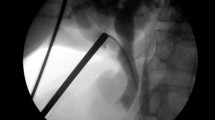Abstract
Background: A purpose-designed transcystic common bile duct (CBD) decompression cannula is described for use as an alternative to T-tube insertion following laparoscopic direct CBD exploration. This permits safe primary closure of the choledochotomy.
Methods: Following direct supraduodenal laparoscopic clearance of large common bile duct stones, the biliary decompression cannula is inserted percutaneously inside its peel-away sheet over a guide-wire into the CBD via the cystic duct. When in place, the cannula is secured to the cystic duct by two catgut extracorporeal Roeder knots and the choledochotomy is then closed. The terminal multiperforated S-shaped segment of the Cuschieri biliary decompression cannula prevents postoperative dislodgement.
Results: Transcystic decompression of the extrahepatic biliary tract using the Cuschieri cannula has been used in 12 patients who underwent laparoscopic supraduodenal CBD exploration for large or occluding stones. There was no instance of postoperative dislodgement of the cannula and all patients had effective drainage of the common bile duct (average 300 ml bile per 24 h). The procedure was uncomplicated in all but one patient who developed self-limiting leakage from the CBD suture line in the early postoperative period. The median hospital stay after surgery was 4 days, with a range of 3 to 10 days. The cystic duct decompression cannula was capped and sealed under an occlusive dressing at the time of discharge. Removal of the cannula was carried out without any complications as a day case 11–16 days after surgery.
Conclusions: Transcystic biliary decompression is safe and effective. The experience with is use indicates that compared to T-tube drainage, transcystic decompression may accelerate recovery and reduce the hospital stay in patients following laparoscopic direct exploration of the CBD. Its insertion is less technically demanding than placing a T-tube through the choledochotomy. Transcystic decompression with complete primary closure of the CBD realizes the full benefits of the single-stage management of common bile duct calculi and permits confirmation of complete stone clearance after surgery.
Similar content being viewed by others
Author information
Authors and Affiliations
Additional information
Received: 5 March 1997/Accepted: 15 May 1997
Rights and permissions
About this article
Cite this article
Hensman, C., Crosthwaite, G. & Cuschieri, A. Transcystic biliary decompression after direct laparoscopic exploration of the common bile duct. Surg Endosc 11, 1106–1110 (1997). https://doi.org/10.1007/s004649900541
Published:
Issue Date:
DOI: https://doi.org/10.1007/s004649900541



